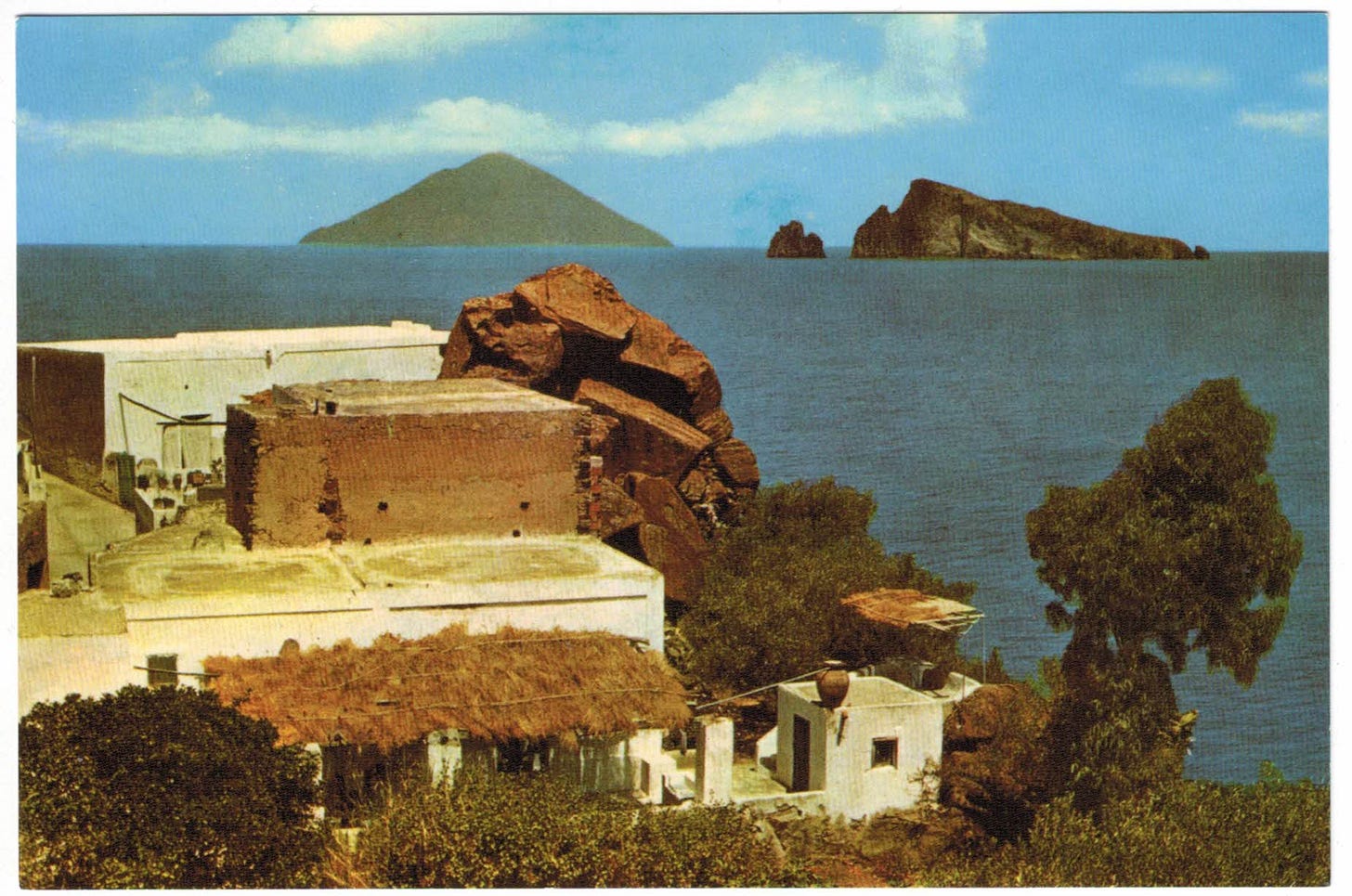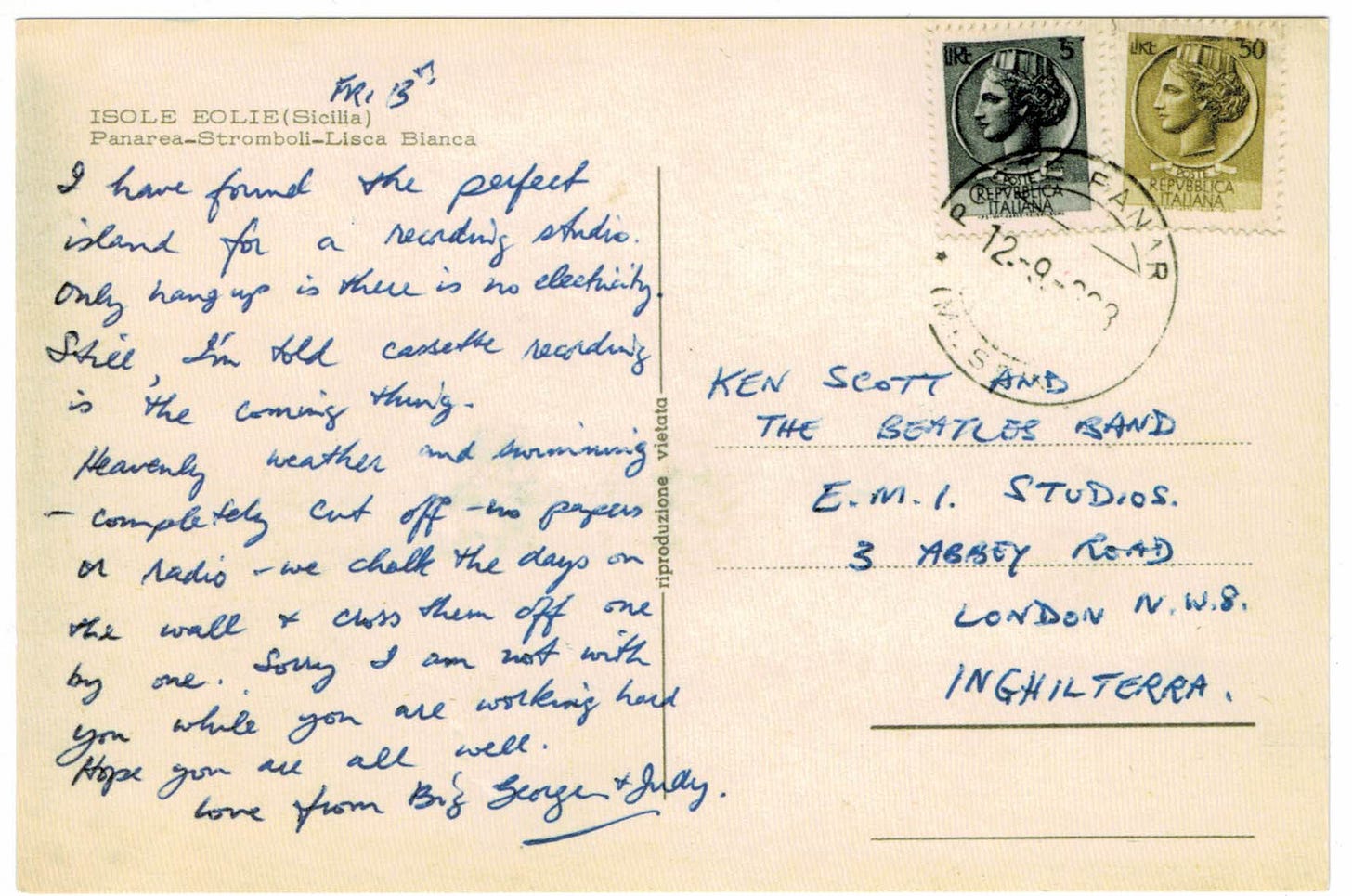George Martin’s 'perfect island' postcard
While the Beatles were recording tracks for the ‘White Album’, the group’s producer sent them a postcard from Italy, saying he’d found ‘the perfect island for a recording studio’.

The Beatles’ producer George Martin played an essential role in realising their creative visions. By 1968, however, the group were increasingly confident in the studio, and didn’t need him as much. In September that year, while the four were recording material for what would become the ‘White Album’, Martin even went on holiday to Italy – leaving any necessary tasks to his assistant.
Martin didn’t forget about the band, of course. While away, he sent them a postcard depicting some of the Aeolian Islands off the coast of Sicily – and what he wrote on it is intriguing:
“I have found the perfect island for a recording studio,” Martin began. “Only hang up is there is no electricity. Still, I’m told cassette recording is the coming thing.”
The reference to an island studio is clearly light-hearted – but it’s fascinating even so. Because one of the reasons given for the Beatles wanting to buy a Greek island the previous year was to make music and have a recording studio there. George Martin had no known involvement in the Greek island discussions – which makes sense, since he was not a fan of Magic Alex. But why was the idea of an island studio on his mind? If the comment came completely out of the blue, it would seem odd. It suggests he and the group had already discussed the topic – perhaps in relation to their Greek dream from the previous year.
Adding further interest to Martin’s observation, about a decade later he did set up a recording studio on an island – for his company Associated Independent Recording (AIR), on Montserrat in the Caribbean. AIR Montserrat opened in 1979, later hosting artists such as the Rolling Stones, Elton John and Paul McCartney. “The studio and its surroundings were gorgeous,” recalled sound engineer Geoff Emerick, who helped create it. “There was a huge picture window in the control room overlooking the bay; you could literally sit at the console and watch the sunset at the same time.”1

The project was audacious – but in his autobiography, Martin says the idea of a “total environment studio” had always appealed to him. He’d previously considered creating one on a ship to give groups “their get-away-from-it-all feeling”. After a two-year search, the choice was narrowed down to a 120-ft yacht in Malta and a 160-ft passenger ferry offered by the Yugoslav government. Despite its challenges, Martin claims the idea was only abandoned due to the 1970s economic crisis.
Hawaii, Canada and Mexico were tempting locations for a land-based facility, adds Martin. While he’d always liked the Caribbean, he was put off by the political instability – until discovering peaceful Montserrat, where he was able to create his “ideal working place”. “Despite the fact that constructing a state-of-the-art studio in such a remote area was an almost impossible task,” said Emerick, “we pulled it off.”
Sadly, the Montserrat studio was abandoned in 1989 after a hurricane ravaged the island. While the building escaped fairly lightly, Martin later commented that changes in the music business combined with the hurricane’s impact meant it was time to close the facility. What remains of it now sits on the edge of an exclusion zone for a nearby volcano, which erupted in 1995.
This creates another point of comparison with Martin’s earlier postcard, whose image includes the volcanic island of Stromboli. What’s more, the Lichadonisia islands – the place in Greece that the Beatles most likely wanted – are also said to have been created by a volcano. These similarities are surely all coincidental. The common thread is the romantic appeal of an island getaway for creating music undisturbed. This vision clearly appealed to Martin. It also appealed to the Beatles in 1967 – and the fact that Martin referenced the idea on his postcard suggests that the group and their producer might have previously discussed this concept.
There are now a number of recording studios on islands, but when Martin created AIR Montserrat, it seems to have been the first such project. When the Beatles dreamed of having one in Greece, it was an even more outlandish notion. In their attempts to realise this ambition, then, the musicians and their producer were once again ahead of their time.
Note: George Martin’s postcard is included as supplementary material in ‘Recording the Beatles’ by Kevin Ryan and Brian Kehew (2006), which is an excellent detailed guide to the technical aspects of the Beatles’ recording sessions as well as the surrounding context. It draws on interviews with many people that worked with the group. Thanks to Professor Jan Hemming at the University of Kassell for highlighting the postcard to me.
Read more:
Here, There and Everywhere: My Life Recording the Music of the Beatles (2006), Geoff Emerick and Howard Massey





